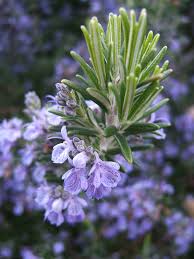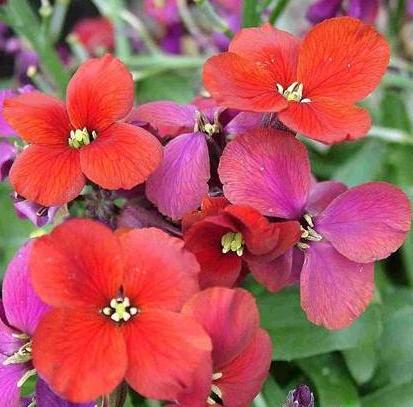 Our landscapes are exploding in celebration of the season, inspiring me to list plants that are sure to entice us back to the soil. In gardens large and small lilac buds are plumped to bursting while forsythias and rosemary plants are in full bloom. Rosemary is especially pretty this spring. Yep, this is the same rosemary that cooks use in the kitchen. Violet blue flowers cover the length of each branch, displaying the best blooms from plants that can bask in at least six hours of sun. The hotter the location the happier the rosemary, just make sure the planting hole has good drainage which is essential to this plant’s well being. Though a gardener’s workhorse, when brushed up against rosemary easily releases its classic fragrance. It’s a popular landscape shrub possessing most of the features homeowners are looking for: an evergreen that has showy flowers, low maintenance, and low water usage. About the only way to kill it is from over watering.
Our landscapes are exploding in celebration of the season, inspiring me to list plants that are sure to entice us back to the soil. In gardens large and small lilac buds are plumped to bursting while forsythias and rosemary plants are in full bloom. Rosemary is especially pretty this spring. Yep, this is the same rosemary that cooks use in the kitchen. Violet blue flowers cover the length of each branch, displaying the best blooms from plants that can bask in at least six hours of sun. The hotter the location the happier the rosemary, just make sure the planting hole has good drainage which is essential to this plant’s well being. Though a gardener’s workhorse, when brushed up against rosemary easily releases its classic fragrance. It’s a popular landscape shrub possessing most of the features homeowners are looking for: an evergreen that has showy flowers, low maintenance, and low water usage. About the only way to kill it is from over watering.
If your fruit trees and vegetable gardens have had difficulty pollinating and setting fruit, plant rosemary in the orchard or next to the garden. It will attract bees even to areas where bee counts have been dropping. Rosemary is irresistible to these essential garden denizens, and while it’s in bloom other fruiting plants in the yard will benefit from the pollination.
Dreaming of a plant bearing huge flower florets, springtime’s sweetest lilac fragrance, able to withstand summer heat, and have great winter color? Dream no more, ‘cause that “dream” plant grows here in Prescott. It’s the Indian Princess Hawthorn. It looks great planted in clusters, as a short hedge, or as a foundation planting. Deer, rabbits, and javalinas are no threats to this homeowners’ evergreen treasure. Additionally, I’m pleased to report that this year’s crop is spectacular and reasonably priced at under $40 for the large, “instant glamour” size.
For a shaded bed or covered patio consider Lily-of-the-Valley. Its lovely clusters of pure white flowers strikingly contrast against the evergreen foliage; right after blooming the leaves take on a tinge of pink, extending the plant’s show. Most varieties are in bloom at garden centers now and ready to plant. Remember, the secret to growing Lily-of-the-Valley is planting it where it gets no midday sun.
I enjoy playing with edible plants as landscape and container accents. My “Artist meets Landscaper” technique has resulted in some of our favorite garden designs. A beautiful plant that fits right into this creative mind set is the artichoke. Its long arching foliage seems to flow from a silver mound, making an ideal addition to any Southwest landscape. Part of an artichoke’s appeal is its almost prehistoric-looking purple thistles. The prickly stems contrast attractively with midnight purple violas flowing over the edge of a large container. I don’t care for the taste of artichokes, but I love growing this perennial vegetable for its extraordinary beauty.
 Having spent decades owning a garden center I’ve seen so many different plants that I rarely get excited over new plants. However, this spring dealt me a jaw-dropping exception in the form of an amazing evergreen perennial, the Red Winter Orchid. Flaming red blossoms in spring gradually change to a royal purple that blooms well into summer. The blooms are bound to bring on giddiness to even the most seasoned gardener! It’s a lot of bloom for the buck so how could I not take home three for my own container gardens? Planted with tall crimson kale and cascading violas, my jade green pot gardens are spectacular! I posted a YouTube viewing of this new plant: [youtube]http://www.youtube.com/watch?v=zZLblla8SXA[/youtube].
Having spent decades owning a garden center I’ve seen so many different plants that I rarely get excited over new plants. However, this spring dealt me a jaw-dropping exception in the form of an amazing evergreen perennial, the Red Winter Orchid. Flaming red blossoms in spring gradually change to a royal purple that blooms well into summer. The blooms are bound to bring on giddiness to even the most seasoned gardener! It’s a lot of bloom for the buck so how could I not take home three for my own container gardens? Planted with tall crimson kale and cascading violas, my jade green pot gardens are spectacular! I posted a YouTube viewing of this new plant: [youtube]http://www.youtube.com/watch?v=zZLblla8SXA[/youtube].
~~ ~~ ~~ ~~ ~~ ~~ ~~
Garden Alert! This week the garden center has been inundated with folks bringing in Pinyon Pine scale samples. I’m afraid that this year’s scourge may reach epidemic proportions. This innocent-looking little bug spreads from tree to tree and has been known to wipe out entire neighborhoods of all pinyons. If you have native pines in the landscape that you want to save, you need to act NOW! Protection is simple and you don’t need to be an arborist to treat your own trees.
The easy solution is a two-step treatment. First, feed everything in the yard right away with ‘All Purpose Plant Food’ 7-4-4; this is especially important for the native evergreens in the yard. Second, apply systemic “Plant Protector’ at the base of the trees you wish to keep healthy. This liquid bug killer works through the trees’ natural systems for yearlong protection. Use a watering can to apply it generously at the base of your trees. It will be absorbed through the plants’ root systems and carried throughout the structures of the trees. As new scale emerge this spring they will attempt to suck the life out of new needle growth, take in the tainted sap, and die. It’s a sure-fire scenario that kills this year’s scale population, but must be set into motion IMMEDIATELY!
Until next week, I’ll see you in the garden center.

